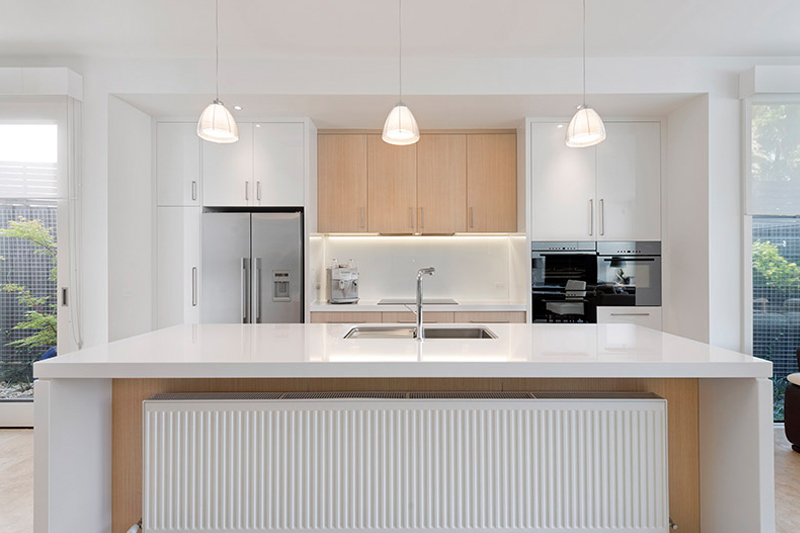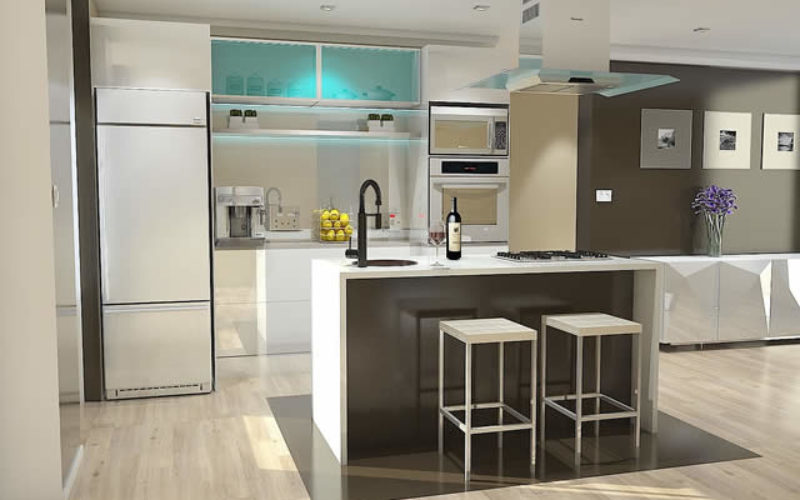Installing a brand new kitchen in an old home requires preparation early on and careful planning throughout. Kitchens are viewed by many people as the hub and heart of the home, the most important room in the house. It is recommended that you visit a kitchen company that does kitchen renovations in Glasgow, Scotland. The kitchen designer will show you a variety of kitchen styles that they have available for you to install in your home. Discuss your budget with your kitchen designer so you have a figure in mind for your kitchen renovations. That way you won’t overspend.
Designing your new kitchen
The most popular route when designing a new kitchen space is to get a kitchen design from the kitchen designer at the kitchen company you have chosen. A kitchen needs an oven, fridge and freezer and sink. Begin with these basic essential items and add appliances around them. Look at your current layout. Consider if you want to add beams or alcoves. You will need sufficient kitchen storage. Your base storage requirements depend on the size of your family, how much kitchen equipment you have and where you store your food. Consider the activities you do in your kitchen. Is your kitchen for food storage, preparation and cooking only or do you want a space to sit and enjoy a meal too? You may need an entertainment space. Is a breakfast bar or kitchen island sufficient or do you need a full-sized table for entertaining? Assess the room’s dimensions then draw up a wish-list of your priorities.
Removing your cabinets and wall units
The more meticulous you are with removing your old kitchen, the easier it will be when you install the new one. You don’t have to remove everything, some parts may be worth keeping. If you have a smaller budget when doing your kitchen renovations in the Glasgow area, check your cabinet carcasses, you could re-use them and only install new doors.
You will need to remove wall units, first off all internal shelves. Units will likely be attached by screws, interconnectors or bolts. When removing the sink, the water needs to be turned off. The main stopcock is usually found under the sink controlling the cold water. The hot water must be switched off at the hot water valve, normally found in the airing cupboard showing a bright red handle. After switching off the taps it takes up to 10 minutes to drain. Undo the waste pipe, catch dirty water in a bucket underneath.
Removing worktops and base units and installing flooring in your kitchen
When you remove your worktops make sure you don’t damage any pipes that run behind or underneath them.Removing the base units is similar to removing wall units. First remove the doors, next unscrew the plinth. Remove any fixings then pull the base units out. When removing the sink ensure you don’t damage any pipes. If you need to chip away tiling, a hammer and bolster can be used. Turn the power off as it’s close to sockets and gloves and goggles should be worn.
Removing vinyl flooring can be done with a stripping knife. You can soften the glue using a heat gun. Removing floor tiles can be a hard job but an SDS drill should work.
Installing your kitchen electrical work
Before you start installing your new kitchen, you will need to fix any electrical work. The electrician from the kitchen company you are using will check the current electrical work and see if any rewiring is needed. If you give your kitchen designer and electrician a floor plan showing where you will need sockets and switches this will help. The electrician will need to come back to do a second fix of electrical work such as sockets before worktops are installed. When sockets are bought remember some appliances like your oven will need a breaker switch so you can turn it off without having to reach a socket.
Attending to your kitchen plumbing
Plumbing in your kitchen renovations involves providing a water supply and removing waste. You will need a hot and cold water supply. A waste pump from the sink to outside will need to be installed and a hot and cold water supply for the kitchen taps. If you want to have a washing machine in your kitchen, you can connect it to both hot and cold water or just cold water. Dishwashers need a cold water connection.
The plumber can assess your pipes and see if they are salvageable or need to be fitted again. You will need to determine if the current pipes will get in the way of your new kitchen’s layout. If you aren’t changing the layout much, then pipes won’t need to be rerouted. Assess the old pipes for damage such as kinks and dents and check the joints. Look out for green marks which could signal a leak.
Fitting your lighting in your new kitchen
A well-lit kitchen is critical as many tasks are carried out in the kitchen. Consider how much natural light comes into the kitchen. A rooflight or bi-fold doors can improve natural light influx. It is a good idea to avoid central light pendants. The light they give off isn’t directed into one area enough and they can cast shadows around the room. A few pendants at a lower level or above island units or breakfast bars work well. Lighting such as downlights and track lights that are adjustable are a good choice. You will need to decide on their positioning with the guidance of your kitchen designer and electrician when doing your kitchen renovations in the Glasgow area.
Under-cabinet lights highlight worktops. If your extractor fan doesn’t have sufficient lighting make sure to add lighting near your oven. Lights that can be dimmed are appropriate to kitchen dining areas, so you can adjust the lights between cooking and entertaining.
Choosing the appropriate flooring in your kitchen
Choosing your flooring should be based on your functional needs and the material’s durability. Kitchen floors need to withstand moisture and stains so this needs to be considered. Good choices include natural stone such as slate or limestone, which must be sealed. You can also choose from linoleum and vinyl. Ceramic or porcelain tiles are a popular choice in kitchen renovations in Glasgow. Solid hardwood floors are also well-liked. They are durable and classic.
Things to consider in small kitchen renovations
If you have a small kitchen space, think about where laundry can be done. Perhaps it can be done in another room. You could also consider if it’s a good idea to knock through into another room to create an open plan kitchen dining area or kitchen living area, creating a greater sense of space. Open-plan living in small kitchens and large kitchens are popular nowadays. You may even consider a broken-plan kitchen layout. Broken-plan kitchens have physical dividers between the kitchen and dining area using room divisions such as different floor finishes, half walls, and shelving units. Creating a broken-plan kitchen improves your kitchen both on a functional and aesthetic level. In order to create a seamless feel between different zones, careful planning is necessary. The zones are created by physical barriers, flooring types, and colour palettes.
Tying together the various steps of your dream kitchen renovation
With the help of a kitchen designer from the kitchen company you are using in Glasgow your kitchen renovations will be on track so you can create your dream kitchen. The kitchen designer will need to speak to you and determine what needs you have for your kitchen. For example do you want a breakfast bar or kitchen island or a full dining area with a dining table? Consider where you will place your appliances too. If you have a smaller budget, check your cabinet carcasses, you could re-use them and only install new doors. You will also need to remove your cabinets and wall units by dismantling them and pulling them out. You will need to remove your worktops without damaging surrounding pipework. The floors need to be stripped, tiles chipped away or vinyl removed.
You need to check your electrical work. If you give your kitchen designer and electrician a floor plan showing where you will need sockets and switches this will help with the kitchen renovations. They will need to do a second fix before installing worktops. The plumber can assess your pipes and see if they are salvageable or need to be re-fitted. You will need to decide if the current pipes will get in the way of your new kitchen’s layout. Directed pendant lights, downlights, and track lights work well in your kitchen. Dimmable lights work well in the dining area of your kitchen. Choosing your appropriate flooring material is important. Good options include natural stone such as slate or limestone. You can also choose from linoleum and vinyl. Ceramic or porcelain tiles are popular too. Solid hardwood floors are durable and classic. In a small kitchen you may want to make it open-plan or broken plan by bashing down a wall and combining the dining or living area with the kitchen to optimise space. Taking these steps into consideration and using your kitchen designer from the kitchen company you have chosen to design your kitchen and their team to install your new kitchen renovations, will ensure you get your dream kitchen!



Recent Comments